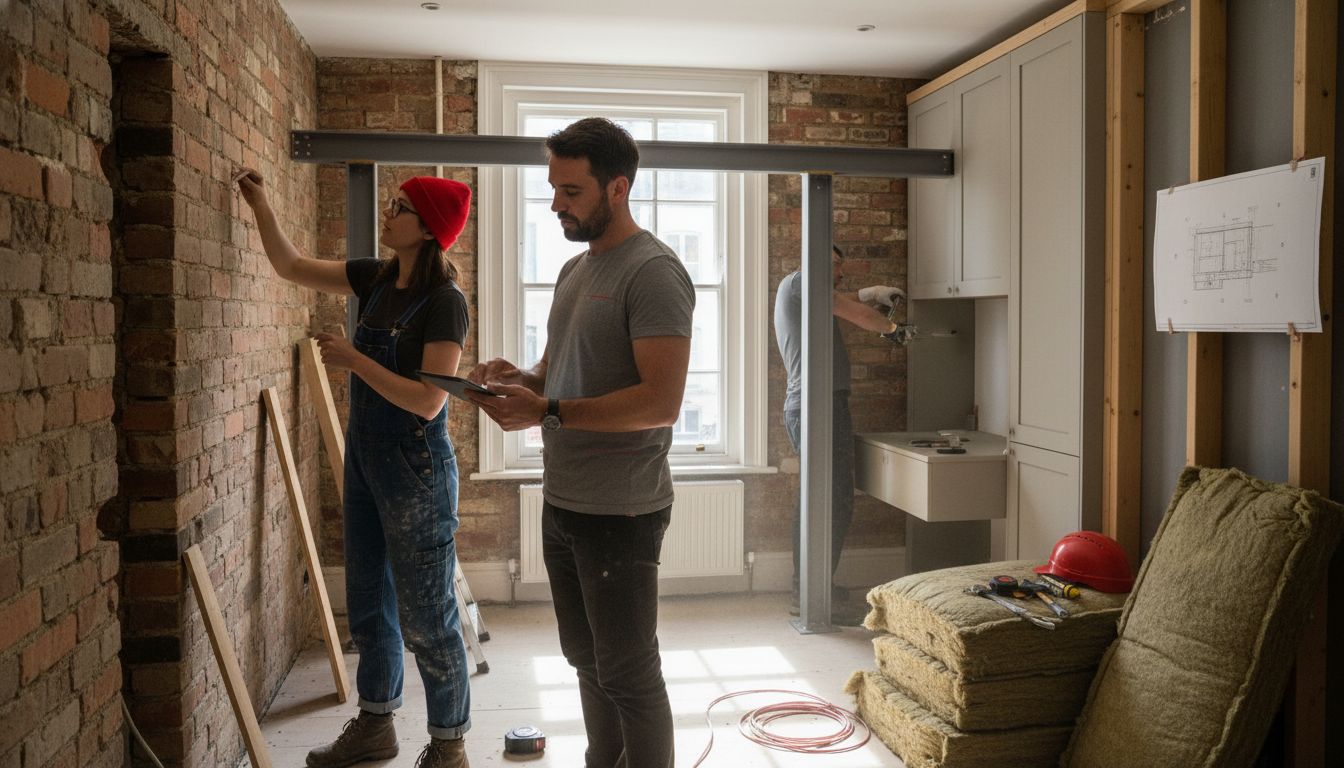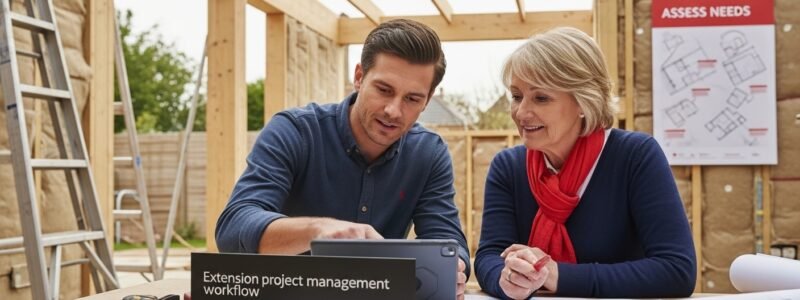London homeowners often underestimate the complexity of adding space to their properties, yet a well-planned extension can boost your home’s value by as much as 20 percent. With space at a premium and regulations constantly changing, getting each step right matters more than ever. Whether you want to create an open kitchen or a dedicated office, this guide walks you through the process, helping you avoid pitfalls and make confident decisions every step of the way.
Table of Contents
- Step 1: Assess Your Current Space Needs
- Step 2: Identify Permissible Extension Options
- Step 3: Design Efficient Layout Solutions
- Step 4: Coordinate Planning And Permissions
- Step 5: Oversee Construction And Quality Checks
Quick Summary
| Key Point | Explanation |
|---|---|
| 1. Assess Your Space Needs | Conduct a room-by-room evaluation to identify pain points and future requirements. Consider both immediate and long-term living changes. |
| 2. Research Permissible Extensions | Investigate local regulations to understand what types of extensions you can build without full planning permission, tailored to your property type. |
| 3. Design Efficient Layouts | Focus on functional and flexible designs that maximize space and facilitate smooth transitions between areas, reducing construction costs. |
| 4. Coordinate Planning Approvals | Contact your local planning authority early to understand requirements and prepare detailed documentation for a smoother approval process. |
| 5. Monitor Construction Quality | Stay actively involved during construction, ensure compliance with quality standards, and conduct regular inspections and documentation of progress. |
Step 1: Assess Your Current Space Needs
Transforming your London home begins with a strategic evaluation of your current living space. Understanding precisely what you need requires a thoughtful and systematic approach that goes beyond simple measurements.
Start by conducting a comprehensive room-by-room assessment. Walk through each area of your home with a critical eye and notepad. Identify current pain points such as cramped living areas, insufficient storage, or awkward layouts that restrict your lifestyle. According to Merton Council, consulting additional resources like Citizens Advice can help homeowners plan and design extensions more effectively.
Your space needs assessment should consider both present requirements and future lifestyle changes. Are you planning to work from home more frequently? Expecting a growing family? Wanting to create a multipurpose area? The HomeOwners Alliance recommends carefully evaluating your extension goals to ensure the project meets both your immediate and long-term living needs.
Pro Tip: Sketch out rough floor plans to visualise potential space improvements before committing to an extension design.
Once you have a clear understanding of your space requirements, you will be well-prepared to move forward with the next steps of your home extension journey.
Step 2: Identify Permissible Extension Options
Navigating the complex world of home extensions in London requires a clear understanding of what you can legally build without extensive planning permissions. This step focuses on uncovering the extension options that align with local regulations and your specific property characteristics.
According to Haringey Council, certain rear extensions might be possible without full planning permission. For instance, single-storey rear extensions can typically extend up to 3m for semi-detached or terraced houses, and up to 4m for detached houses, provided you are not in a conservation area or dealing with a listed building. Hounslow Council further advises homeowners to carefully consider the size, design, and position of potential extensions to ensure compliance with local planning policies.
To identify your permissible extension options, start by researching your specific property type, local conservation status, and immediate architectural surroundings. Consulting Permitted Development Extensions can provide additional insights into the potential scope of your project without triggering complex planning requirements.
Pro Tip: Always check with your local planning authority before finalising any extension designs to confirm specific regulations for your exact location.
Understanding your extension possibilities sets the groundwork for a successful home improvement project that maximises your living space while staying within legal boundaries.
Step 3: Design Efficient Layout Solutions
Designing an efficient home extension requires strategic planning that balances functionality, aesthetics, and cost-effectiveness. This crucial step transforms your vision into a practical blueprint that maximises your available space and meets your specific lifestyle needs.
According to the Federation of Master Builders, prioritising simple design principles can significantly reduce construction costs and complexity. Focus on creating clean lines and multipurpose spaces that serve multiple functions without unnecessary architectural complications. Hounslow’s Residential Extension Guidelines recommend carefully considering how each area will connect with existing rooms to ensure smooth transitions and optimal flow.
When developing your layout, consider key factors such as natural light, traffic patterns, and potential future needs. Think about creating flexible spaces that can adapt as your lifestyle evolves. For example, design open plan areas that can be easily reconfigured or include clever storage solutions that maximise every square metre of your new extension.
Pro Tip: Sketch multiple layout options and compare them critically before finalising your design.
By approaching your extension design with thoughtfulness and creativity, you will create a space that not only meets your current requirements but also adds significant value to your London home.

Step 4: Coordinate Planning and Permissions
Navigating the intricate landscape of planning permissions is a critical step in your home extension journey. This stage transforms your design from a concept into a legally compliant project that can move forward with confidence and clarity.
According to the Federation of Master Builders, the first crucial action is contacting your local planning authority to determine exactly what permissions your specific project requires. Each London borough has unique regulations, making direct consultation essential. Harrow Council highlights that the prior approval process can take up to 42 days and typically involves providing detailed information about your proposed extension and consulting with immediate neighbors.
Prepare a comprehensive documentation package that includes detailed architectural drawings, site plans, and a clear explanation of how your extension meets local building regulations. This proactive approach demonstrates your commitment to compliance and can significantly streamline the approval process. Consider consulting Planning Permissions for additional guidance on navigating local requirements effectively.
Pro Tip: Schedule a pre-application consultation with your local planning department to identify potential issues before submitting formal documentation.
By methodically managing the planning and permissions process, you set a solid foundation for a successful home extension that meets all legal requirements.
Step 5: Oversee Construction and Quality Checks
The construction phase of your home extension is where your careful planning transforms into tangible reality. This critical stage demands active involvement, meticulous attention to detail, and consistent quality monitoring to ensure your project meets every standard and expectation.
Merton Council emphasizes the paramount importance of obtaining building regulations approval to guarantee safety and quality standards throughout the construction process. Similarly, the Federation of Master Builders advises homeowners to prioritize permanent, high-impact investments and collaborate exclusively with reputable builders who can demonstrate compliance with rigorous regulatory requirements.
Schedule regular site visits to track progress, verify work quality, and address potential issues immediately. Document each stage of construction with photographs and detailed notes, maintaining open communication with your construction team. Pay special attention to critical structural elements, insulation, plumbing, electrical work, and overall craftsmanship. Conduct thorough inspections at key milestones to ensure every aspect of the extension meets your initial design specifications and building regulations.
Pro Tip: Request detailed progress reports and maintain a written log of all discussions and decisions made during the construction phase.
By maintaining an engaged and systematic approach to construction oversight, you will safeguard the quality and integrity of your home extension project.
Make Your London Home Extension Dream a Reality Today
Maximising your living space in London through a smart home extension can feel overwhelming when faced with legal hurdles and design complexities. This article highlights common challenges like navigating planning permissions, ensuring efficient layouts, and maintaining quality during construction. If cramped rooms, confusing regulations, or future-proofing your space keep you awake at night, you are not alone. Many homeowners share these concerns when planning to enrich their homes without relocating.
At Reltic Extend, we understand your goals to create modern, functional, and stylish extensions that fit your lifestyle now and in the years ahead. Our expert team specialises in bespoke home extensions across London and Surrey, delivering clear, stage-by-stage pricing and handling all planning permissions on your behalf. Explore inspiring ideas with our Extension Inspiration & Ideas for Your Home or get practical advice on layouts with our Design & Build Tips for Home Extensions.
Why wait to unlock your home’s full potential? Get personalised support from initial design through to seamless project completion with a 10-year structural guarantee. Take the first step and connect with us via contact page to turn your vision into a reality with confidence and ease.
![]()
Frequently Asked Questions
How can I assess my current space needs for a home extension?
Start by conducting a room-by-room evaluation of your home. Identify pain points such as cramped areas or insufficient storage, and jot down your current and future needs to guide your extension project.
What extension options are permissible for my London home?
Research the specific regulations for your property type to determine what extensions you can build without extensive planning permissions. Look for details on maximum dimensions and design requirements to ensure compliance with local policies.
How can I design an efficient layout for my home extension?
Focus on creating a layout that emphasizes functionality and flow. Sketch out multiple options that maximize natural light and accommodate future needs, ensuring each area connects seamlessly with existing rooms.
How do I coordinate planning and permissions for my home extension?
Start by consulting your local planning authority to understand what permissions are needed for your project. Prepare a comprehensive documentation package that includes architectural drawings and a project description to facilitate the approval process.
What steps should I follow during the construction phase of my home extension?
Actively participate in the construction process by scheduling regular site visits to monitor progress and quality. Document each construction stage and communicate regularly with your builders to address issues promptly and ensure adherence to your design specifications.
How can I ensure quality checks during my home extension construction?
Schedule inspections at key milestones in your construction timeline to evaluate the quality of work. Focus on critical elements like insulation and plumbing, and maintain a log of all discussions and decisions made to safeguard your project’s integrity.





